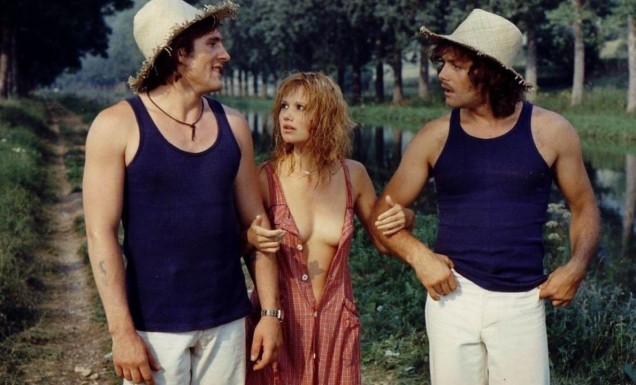Going Places
Les valseuses, comedy, crimenalistički, France, 1974
DIRECTED BY: Bertrand Blier

CAST:
Gérard Depardieu,
Miou-Miou,
Patrick Dewaere
SCRIPT:
Bertrand Blier,
Philippe Dumarçay
PHOTOGRAPHY:
Bruno Nuytten
MUSIC:
Stéphane Grappelli
EDITING:
Kenout Peltier
Synopsis:
Young Jean-Claude and his best friend Pierrot are quite bad guys, capricious and unpredictable criminals who in the French province during the first half of the 70s of the last century carry out various heinous acts and crimes.
They travel to France in search of adventure, excitement and sex, and besides attacking and harassing women, they are intensely prone to theft and more serious crimes. But while they rob pedestrians or steal unattended vehicles, and while they get into and out of a lot of trouble, Jean-Claude and Pierrot do it with a lot of charm and almost completely harmless. They seem to be unaware of their own actions and their gravity, and what they do essentially amounts to stealing everything that is dear to the French bourgeoisie, from cars to wives and daughters to family peace.
One night, during a robbery of a shop whose owner is actually a pimp, the two kidnap the prostitute Marie-Ange. Although during the action Pierrot is shot in the crotch, shortly afterwards he gathers enough energy to rape the kidnapped girl. At the same time, he is surprised by the detail that Marie-Ange reacts unusually to the violent sexual relationship, because not only does she seem to like the abuse, but she soon decides to fulfill a strange wish for both of them.
But these are not all the oddities and extravagances that Jean-Claude and Pierrot will show over time, for example when they soon meet an attractive young mother, or when they experience a tragic accident with a girl who has recently been released from prison.
The adventure crime-comedy The Waltz Dancer by co-writer and director Bertrand Blier is his third feature film, a work which, due to explicit erotic and partly sexual scenes, a certain amount of vulgarity and an affirmative portrayal of immorality, is considered one of the most controversial in the entire French cinematography.
Such authorial tendencies are already evident in the original title of the film, because the term 'les valseuses' in French slang at the time the film was shot was a synonym for the English term 'the waltzers', which was the name for the testicles, although in the Croatian translation it is literally translated.
Although at the time of its premiere, due to all of the above, it was received rather harshly and even negatively by critics, the film later experienced a revaluation, and younger and modern critics declared it a cult work.
Blier based the film's script on his own novel also titled Les valseuses, which was published in 1972, and which was translated into a screenplay by the respected Philippe Dumarçay. The shooting of the film was not without inconveniences and problems, which were in part related to the rather erotic performance of the then very popular Miou-Miou (Nobody and the Indians by Damian Damiani, Među nama by Diane Kurys), and to a greater extent by the scene of sucking a woman's breast on the train, played by Brigitte Fossey (Robert Altman's Quintet, Giuseppe Tornatore's New Cinema Raj). During the filming of that scene, she was, according to the director, 'a little scared', while later she herself admitted that she 'got dizzy, because in the sex scene she found herself in an uncomfortable position between two men'.
Despite all the above, the final result is a work characterized by the ease of storytelling, infectious anarchy, playful acting interpretations, an effective visual setting that exudes a certain warmth, and for which the award-winning cinematographer Bruno Nuytten (Jean de Florette by Claude Berri, Camille Claudel, whom he himself and directed), and great music by Stéphane Grappelli. The role of Jean-Claude is responsible for the beginning of Gérard Depardieu's affirmation as an actor, who would later make seven more films with Bertrand Blier, and the intriguingly stylized episodic role of Jeanne Moreau should also be singled out.
Text author: Josip Grozdanić
color, 118'